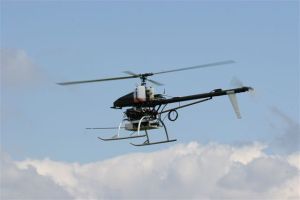Aero-ground-joint inversion
Combining advantages and possibilities of airborne and ground-based electromagnetic data
Our problem: How to put together different sets of electromagnetic data in one place and get it right?
In this sub-project it is intended to enhance the resolution of model parameters through the development of a joint inversion algorithm for helicopter-borne electromagnetic (HEM), transient electromagnetic (TEM), and
radiomagnetotelluric (RMT) data sets. The proposed concept of the joint inversion takes advantage of each single
method, which in most cases consists of a dense measuring grid (HEM and RMT) and provides
the capability to resolve near surface (RMT) and deeper electrical conductivity structures (TEM). HEM-, TEM-, and RMT-measurements are widely used in practical environmental, geotechnical, and exploration problems.
Helicopter-borne electromagnetic (HEM) measurements are an effective way to map the electrical conductivity of
large areas. The typical scenario is first to identify the geophysical property that is diagnostic of the sought
geological structure or buried object. The map, however, presents no information about the depth of the object or
details regarding its shape. The depth of investigation of HEM-data is rather limited compared to EM sounding
methods on the ground.
In order to improve the accuracy of model parameters of shallow depth as well as of the
deeper crust, we plan to combine HEM, TEM, and RMT measurements by using numerical joint inversion
methodology. However, in most cases, the measuring grids of each single method will not overlap with each other.
 Miniatur helicopter in flight
Source: Johannes B. Stoll, MGT
Miniatur helicopter in flight
Source: Johannes B. Stoll, MGT
Our solution: Unify measuring grids! Complement data by use of UAS based RMT measurements!
A reduction of all measuring grids to one grid requires either an interpolation algorithm or the introduction
of smoothing conditions in the parameter space. Such algorithms are not available at present and shall be realized in this project. At the moment, there is no inversion method which enables the joint interpretation of HEM-, TEM-, and RMT-data.
In addition to RMT ground data and existing TEM and helicopter borne EM-data, we propose a new deployment of the so called Unmanned Aerial System (UAS), an innovative platform for airborne VLF/LF-measurements on a
regional scale. An UAS shall be utilized to perform geophysical surveys on a flying measuring platform. The
utilization of UAS enables the performance of a time and cost-effective measuring platform to acquire high
resolution images of geophysical parameters of electrical conductivity. Since many decades, VLF-measurements are a well established method in exploration geophysics on the ground as well as in airborne geophysics. These
qualitatively provide an indication about lateral changes of the electrical conductivity of the ground.
An innovative electromagnetic induction coil system will also be applied, which measures the EM field of VLF/LF
and radio transmitters over a broad range of frequencies (10 kHz to 250 kHz). In 2008, METRONIX GmbH released an induction coil triple, the so called Super High Frequency Triple (SHFT)-sensor, which enables sensing the radiated magnetic field of VLF/LF-transmitter stations. This sensor was already deployed in a Swedish airborne geophysical survey performed by Pedersen und Dynesius (2008). This method allows determination of the electromagnetic impedance tensor over a large depth range and yields images of complex 3D conductivity structures. Finally, a transform function is used to derive the electrical conductivity from the magnetic field measured at different evaluation frequencies. According to the number of radio stations, many evaluation frequencies are available at a site, which considerably improves the depth resolution and is a significant advantage of this method. In addition, UASs have the potential to open new possibilities concerning the organisation and performance of geophysical exploration.
Contact 1:
Contact 2:


